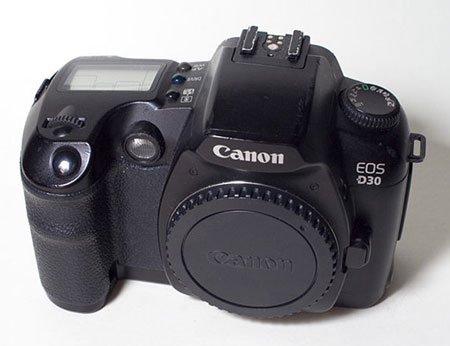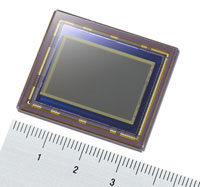The Digital Sensor: A Guide to Understanding Digital Cameras
by Wesley Fink on April 21, 2008 1:00 AM EST- Posted in
- Digital Camera
CCD and CMOS
At the dawn of the digital SLR era, almost every sensor was a CCD (Charge Coupled Device). CCDs were relatively easy to make, but they were and remain basically a single function sensor. CCD sensors create very high image quality and low noise, but they require support circuitry for almost every function provided by the CCD. The CMOS (Complementary Metal Oxide Semiconductor) sensor was always a possible alternative in sensor design, but manufacturing CMOS sensors was very difficult with the technology available at that time. CMOS sensors are inherently lower image quality and higher noise than CCD, which led some experts to predict that a production CMOS sensor for DSLR imaging would never be made.
There are many reasons manufacturers would have preferred the alternative of the CMOS sensor. While difficult to manufacture they are much cheaper to make in volume than CCD sensors. Power consumption for CMOS is inherently lower than the CCD sensor. In addition, the CMOS sensor lends itself to integrating other electronics, such as the analog to digital conversion and noise reduction electronics into the sensor itself - something not really possible with the CCD design.

Those who did not think a commercial CMOS sensor was possible were silenced with the introduction of the $3000 Canon D30 in the fall of 2000. Canon has championed the CMOS sensor, almost exclusively, since that time. However, in the past year other sensor manufacturers have been able to produce their own CMOS sensors. As a result, almost every new sensor introduction in recent months has been CMOS.

In fact, Sony was the first to market with a 12MP+ APS C size CMOS sensor, used in the Nikon D300 and Sony A700. This was followed in about 6 months by the introduction of the Samsung 14.6MP APS-C CMOS sensor in the Pentax K20D. It appears other sensor makers who previously trailed Canon in CMOS development are now the ones pushing the envelope in CMOS sensor development. Sony has also announced a 24.81 effective megapixel CMOS sensor that will be used in a full-frame Sony later this year that will likely be called the A900. The Sony and Samsung thrust into CMOS sensors makes more sense when you realize that Sony and Samsung jointly own several recent patents in CMOS technology. Panasonic is also producing CMOS sensors as seen in their LiveMOS sensors used in the Olympus E-3 and E-501/410/420.

LEFT: Conventional Image CMOS Image Sensor Circuit Structure
RIGHT: Column-Parallel A/D Converter CMOS Image Sensor Circuit Structure
Sony has also taken advantage of another CMOS capability by combining analog to digital conversion and image noise reduction on the CMOS sensor itself in the 12.2MP A700. Some photo review sites had apoplectic fits when they realized Sony was doing noise reduction on the A700 chip, but this is an inevitable development. This move to larger integration of electronics into the CMOS sensor module is just starting, and it could eventually lead to a much larger scale integration of digital image processing functions into the sensor chip - or even a camera on a chip.










72 Comments
View All Comments
melgross - Monday, April 21, 2008 - link
The smaller process technology will have no positive effect on the sensors themselves, though it will for the associated electronics integrated on the die.The same problems he mentioned about smaller sensing sites will remain. The smaller the sensor, the poorer the performance viz a viz larger sensors.
He did mention that the photo division was the purchase, not the entire company (unless he changed the article after your post).
Wesley Fink - Monday, April 21, 2008 - link
I changed the wording on the Sony purchase a bit to better reflect that Sony bought the Minolta camera assets of KM and not the company. Thanks for pointing this out.finbarqs - Monday, April 21, 2008 - link
Canon's 1DS MK2 was a 16.7MP CMOS sensor also, and of course, the MK3 is a 21MP CMOS sensor...Where i'm lost is if CCD's are so much better (in IQ) why dont' they stick with CCD's? why the move to CMOS besides the lower cost and the battery life that it saves?
Why are professional level DSLR's (From canon and Nikon) are both CMOS when we know that CCD is the way to go for better IQ?
melgross - Monday, April 21, 2008 - link
It USED to be true that CCD's were better. Not so any longer. The best CMOS sensors are better than the CCD's they replace.The desire to go CMOS is obvious to the manufacturers of the sensors.
CCD sensor technology is a completely different manufacturing process from that of CMOS, which the entire industry uses for everything else (almost).
Moving to that allows CMOS sensors to not only be able to integrate other electronics on the sensor chip, resulting in simplicity, price advantages, and the ability to more favorably utilize their process lines, but that higher quality you're concerned about.
Putting functions on the same chip improves the quality of the signals.
And, by the way, an error in the article: Canon was not the first to make, or use, a CMOS sensor. They were the first to come out with a high quality sensor. I believe that it was Vivitar that used the first one, though I forgot the name of the manufacturer.
Anther omission is that there are trilinear sensors used in camera backs such as the Betterlight scanning backs. So there are three different major technologies in use.
And not all of the negatives of the Foveon chip was mentioned.
s12033722 - Monday, April 21, 2008 - link
No, CCD is definitely still the IQ king. CCD still has a far better SNR than any CMOS technology.As a digital camera design engineer, I deal with image sensors every day. The major reasons why CMOS sensors are attractive are all cost related. Not only are CMOS sensors themselves cheaper, but they lend themselves to integration with other electronics better and they are MUCH nicer to design with. A typical CMOS sensor will require ground, 3.3V, and maybe some other standard voltages (1.8V, 2.5V, etc.), whereas a typical CCD will require ground and anything from 8 to 12 other DC voltage rails. For instance, I am working on a camera that requires -15V, -9V, -6V, -4V, -1.5V, ground, 2V, 3.5V, 11 V, 15V, 24.5V, and has a clock signal that must run up to 40V. While making the voltages and driving clocks at them is fairly straightforward, it requires a lot more components than a CMOS sensor design would. More components directly equals higher cost. Also, as the article mentions, more functions can be integrated onto CMOS sensors than CCDs.
The other advantage of CMOS vs. CCD is in random-access readout. If you want to read a small region of interest on a CCD, you either have to read out the whole frame and digitally ignore the parts you don't care about (no increase in read speed) or the chip has to support charge dumping, where portions of the image can be dropped without reading them out. CMOS makes it much easier to read small portions of the image, and thus things like live view are simply done.
Lastly, I'd like to mention an issue with the Foveon sensor that the article didn't mention. While the foveon technology presents itself as having three discrete pixels stacked on top of each other, the reality is much more ambiguous. Foveon relies on the ability of different wavelengths of light (colors) to penetrate to different levels in silicon, however, far from being discrete, easily separated regions, the depth of capture of different wavelengths in silicon tends to be very blurry and ill defined. This results in significant color mixing in the foveon design. They manage to pull out the images they do through the use of extensive processing. That makes the technology pretty unappealing to design with, thus the dominance of Bayer sensors. Honestly, if I needed to do a camera with true RGB per pixel, I would use a 3-CCD design where a full sensor is dedicated to each color rather than using anything like a foveon. It would be more expensive, but far better quality.
Wesley Fink - Tuesday, April 22, 2008 - link
Thank you for clarifying several points from the Design Engineer perspective. I appreciate your insights into the CCD vs. CMOS issues.Sometimes it is difficult for people to wrap their heads around the idea that a technology (CMOS) is not the low noise champion, but that it is winning nonetheless because of other attributes such as lower cost, manufacturing efficiency, lower cost, integration advantages, lower cost, lower power consumption, and lower cost. Your comments put that reality into perspective.
melgross - Monday, April 21, 2008 - link
That's all very interesting, but unless you are designing a very high IQ, special purpose (read, very expensive) device, that's simply not an assumption that can be made..CCD's have numerous problems. High power requirements, which lead to higher temperatures, which leads to higher noise levels, requires cooling for the best results, and so on.
There is no inherent IQ advantage to CCD's. The longer development time led to an early start, and all the advantages accrued from that. But that lead shrunk.
Also, when talking about cost/performance, we must realize that it is very important to not lose sight of the fact that performance must be compared at reasonable cost levels. NASA can afford to spend a million for a sensor, which they do, but it's irrelevant to everyone else.
As for the Foveon chip, yes, that is one of the problems I was talking about, and the biggest one.
Some enthusiastic reviews and articles have taken Foveon's word that they undergo little processing compared to Bayer chips. That's only true in the de-matrixing area, and so they don't need a the aliasing filter. But the color mixing problems are just as serious, and I've found, in using the camera, that color quality is more variable than with my 5D. Often noticeably poorer as well.
7thSerapHim - Monday, April 21, 2008 - link
As stated on the Canon CMOS Technology page, it says that although CCD sensors achieve high IQ, they are have slow data-reading speed, which means that it wouldn't be capable to capture at a fast FPS mode.CMOS is capable of high data-reading speed, but due to crosstalk (between pixels) the IQ suffers as a result. However, due to developments in CMOS technology, we can assume that IQ has improved closer to CCD.
My opinion is that the cost, speed, battery life and potential for improvements is what compelled many to adopt CMOS instead of CCD.
Zak - Monday, April 21, 2008 - link
I've recently bought Canon 40D that uses CMOS (right?) and I'm a bit disappointed in the image quality over my Rebel XTi (dead). There is definitely much less noise and it's incredibly fast, but I just can't get images to be as sharp as with the XTi. In particular with 100mm Canon macro lens. I don't know if I got a defective body or the CMOS sensor is indeed softer than CCD in the XTi. I'm considering returning the 40D and fixing my XTi instead.Z.
strikeback03 - Tuesday, April 22, 2008 - link
Canon typically tunes the JPEGS from the entry-level bodies to be more "punchy" (more saturation, more sharpening, more contrast) than on higher-level bodies, to provide results closer to the average P&S output.If RAW, might just be processing variations between RAW profiles for different bodies. Have you tried some sharpening in photoshop or similar to compare images?
Also possible the body is missing focus, but before jumping to that conclusion I'd try the image adjustments first.